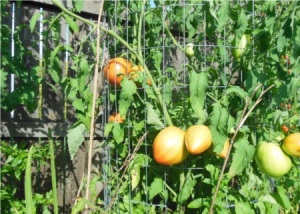Welcome back to Kitchen Stadium for a special edition of Iron Chef… In The Garden.
Let’s listen in on the Chairman as he announces the secret ingredient.
Huh?
Not to be rude, but what the heck are you talking about? And what does this have to do with Iron Chef?
Well, I have a small confession. These ingredients have absolutely nothing to do with Iron Chef. You can say I’m full of fertilizer. Actually, these secret ingredients are fertilizer. They have everything to do with turning your plants into fine, large specimens with the biggest harvests.
Think of Warren Buffet in the financial world, Oprah in the entertainment world, Wilt Chamberlain on the dating scene. Side note- 20,000 women, Wilt? It’s amazing you could even walk, let alone run down the basketball court…
That’s how well your plants will fare with periodic feeding… in the garden. And to clarify, when I say fish guts and seaweed I mean hydrolyzed fish and liquid kelp.
What exactly are these? Let’s start with hydrolyzed fish. Either whole fish or fish scraps are processed with enzymes to break down some of the more complex proteins. Unlike fish emulsion, it is not heated. The end result looks like a peanut butter milkshake. But for God’s sake don’t drink it. And don’t pour it on your plants.
Wait a second… isn’t this supposed to be fertilizer? Why aren’t we putting it on the plants?
We will be putting fertilizer on the plants. And I guess we are pouring or spraying it on the plants. But we aren’t POURING the fertilizer on the plant. Too much of a good thing will end up burning the plant- undiluted this is more like the creature’s acid blood in the movie Alien. It needs to be diluted to prevent harming the tender leaves. Usually 1 tablespoon per gallon of water is plenty.
Liquid kelp is a concentrate of kelp harvested from the ocean and liquified. The same rules apply to this fertilizer. As tempted as you may be to drink an oily black-green liquid, don’t do it. Only 1 tablespoon per gallon of water, please. The kelp actually smells more like fish than the hydrolyzed fish. Ever hear the one about the blind guy that walked by the fish market?… um, never mind.
How do you apply this fertilizer? You should give foliar feeding a try. Instead of (or in addition to) watering or spraying the ground around the plant, spray the leaves. More of the fertilizer is absorbed by the plant using this method, leading to better results. And how well does it work? Check out a recent shot of tomatoes below.
A special thank you goes out to my coworker Mike G., who introduced me to these products. Thanks Mike! PS- you can use me as a reference.












